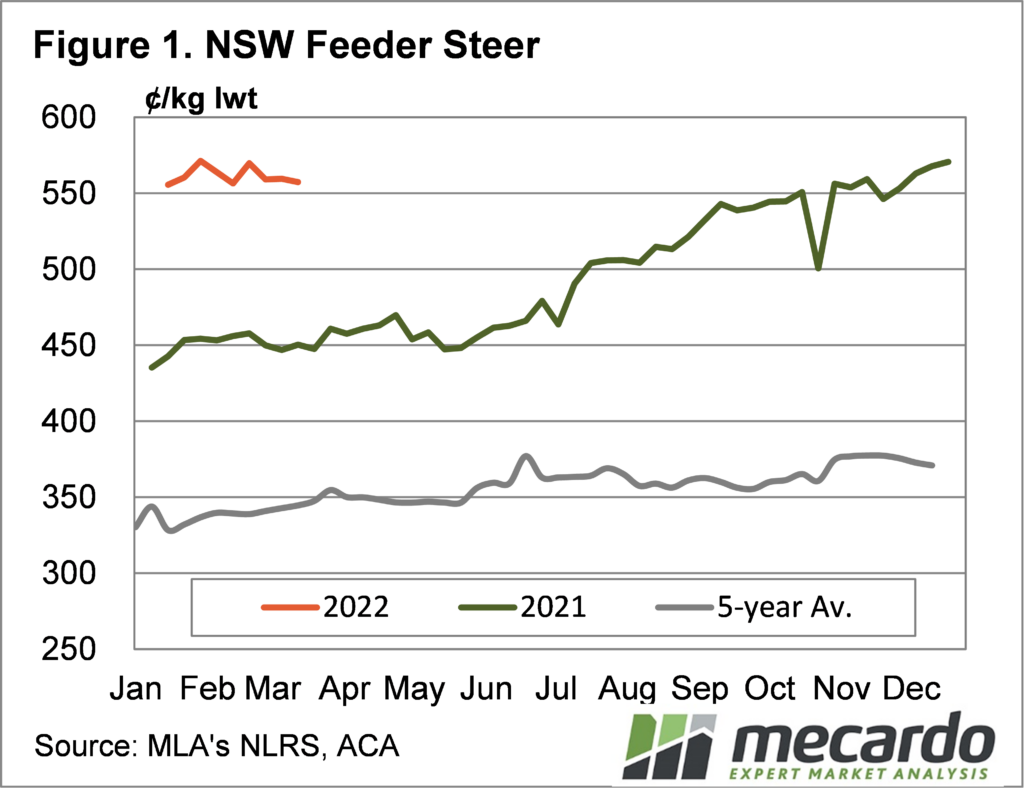The feeder cattle market looks to have peaked, but remains at extremely strong levels. A subscriber enquired recently as to whether there is more upside, and when and how far prices will recede when they finally come off. Here we take a look at the possibilities.
This time last year when feeder prices were sitting around 450¢/kg lwt there was conjecture as to how long the high prices could last. No one really expected prices to add a further 100¢ or more to take a 400kg feeder past $2,200 per head.
Figure 1 shows that the price rises have stalled, with the NSW Feeder Steer Indicator having gone sideways for the best part of five months. It’s not hard to work out how prices got to this level. For lotfeeders the equation is relatively simple. With trade steers making over 1000¢/kg cwt and heavy steers over 850¢, grain finished cattle are making $2,900-$3,000 per head.
With feed grain prices rising the cost of feed has gone up, and margins have been squeezed but lotfeeders are still able to pay $500 less than the finished price. Hence feeder prices are static around 550¢/kg lwt.
To see feeder prices to shift lower either the grain price has to rise, the finished cattle price fall, or the supply of feeder overwhelm demand. First a quick look at grain prices.
Regular readers will know the grain market is extremely volatile at the moment, but local feed consumers have been somewhat sheltered from this by the record harvest and strong supplies. With international feed values boosted by the war there is some risk feed grain prices could gain up to $100 over the coming year. This could strip 20-30¢ off feeder cattle prices, so would not be disastrous for prices.
Finished cattle prices are largely driven by export beef values, which are currently close to record highs (figure 2), at least for 90CL. We can see the NSW Heavy Steer prices hasn’t reacted to the latest lift in the 90CL, but that is likely due to higher quality beef export prices remaining static, while manufacturing beef rises.
There is a risk export beef prices could fall, as cost of living expenses bite in our export markets, but downside is not huge with US beef production expected to weaken, providing support.
Increasing young cattle supply is the final factor that could see prices fall. Autumn generally sees cattle supplies boosted with the end of the northern wet season, but restocker demand remains extremely strong, and is likely to soak up extra supplies in the short term.
What does it mean?
While it’s hard to make a case for rising feeder cattle prices, it’s equally difficult to see values falling too far in the current environment. Rising grain prices could take 20-30¢ off the price, with weakening export possibly stripping a further 30¢. Losing 50¢/kg lwt would equate to more than $200 per head, and would be an issue for traders, but it doesn’t look likely in the short term.
Significant price falls would be more likely with weak winter/spring rain, and this looks to be where the major downside price risk is now.
Have any questions or comments?
Key Points
- Feeder prices are close to record highs sitting above 550¢/kg lwt.
- Key risk factors for feeders are grain price, export beef values and young cattle supply.
- Short term price movement looks limited, but there is downside risk in the spring.
Click on figure to expand
Click on figure to expand
Data sources: Mecardo, MLA, Steiner



